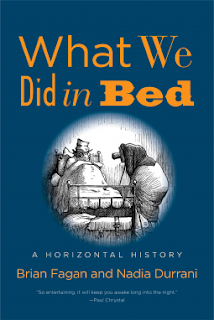* Copy courtesy of NetGalley & Yale University Press *
I'm fascinated by sleep, so when I saw What We Did In Bed: A Horizontal History by Brian Fagan & Nadia Durrani was available on NetGalley it was a no-brainer.
This non-fiction gem contains a history of beds through time, including changes in beds from the Egyptian Pharaohs all the way to the modern age. Sleeping habits are discussed, including bed sharing amongst family members and travelling strangers and co-sleeping with children.
Dreams, sex, childbirth and death are all activities that happen in bed and are given much consideration within the text.
Futons, reed mats, raised beds, beds on ropes, bundling boards, truckle beds, pallet beds, waterbeds and inner spring beds are all covered with interest. Deathbeds and funerary couches were a highlight, as were the seemingly excessive bedding layers required to make a Victorian era bed.
It was fascinating to learn medieval Europeans slept at an angle partially upright, and that the witching hour was first recorded in 1883 and took place between midnight and 4.00AM.
I enjoyed reading about famous people who required very little sleep, including Winston Churchill, Leonardo da Vinci, Voltaire, Benjamin Franklin, Thomas Edison and Napoleon. Modern day 'short sleepers' include Margaret Thatcher, Bill Clinton and Donald Trump.
However, I was most pleased to discover What We Did In Bed included one of my favourite sleep related topics: segmented sleep and the fact that we used to sleep in two four hour chunks with a gap of wakefulness in between. The author of one of my favourite books At Day’s Close - A History of Nighttime by A. Roger Ekirch was referenced together with his thoughts on biphasic sleep.
Authors Fagan and Durrani explain on page 4:
What We Did In Bed: A Horizontal History by Brian Fagan & Nadia Durrani is recommended reading for anyone with an interest in beds and sleep across history.
Carpe Librum!
I'm fascinated by sleep, so when I saw What We Did In Bed: A Horizontal History by Brian Fagan & Nadia Durrani was available on NetGalley it was a no-brainer.
This non-fiction gem contains a history of beds through time, including changes in beds from the Egyptian Pharaohs all the way to the modern age. Sleeping habits are discussed, including bed sharing amongst family members and travelling strangers and co-sleeping with children.
Dreams, sex, childbirth and death are all activities that happen in bed and are given much consideration within the text.
Futons, reed mats, raised beds, beds on ropes, bundling boards, truckle beds, pallet beds, waterbeds and inner spring beds are all covered with interest. Deathbeds and funerary couches were a highlight, as were the seemingly excessive bedding layers required to make a Victorian era bed.
It was fascinating to learn medieval Europeans slept at an angle partially upright, and that the witching hour was first recorded in 1883 and took place between midnight and 4.00AM.
I enjoyed reading about famous people who required very little sleep, including Winston Churchill, Leonardo da Vinci, Voltaire, Benjamin Franklin, Thomas Edison and Napoleon. Modern day 'short sleepers' include Margaret Thatcher, Bill Clinton and Donald Trump.
However, I was most pleased to discover What We Did In Bed included one of my favourite sleep related topics: segmented sleep and the fact that we used to sleep in two four hour chunks with a gap of wakefulness in between. The author of one of my favourite books At Day’s Close - A History of Nighttime by A. Roger Ekirch was referenced together with his thoughts on biphasic sleep.
Authors Fagan and Durrani explain on page 4:
.. a practice known as segmented sleep that seems to have been commonplace before electric light turned night into day. People slept for, say, four hours, after which they would awaken and spend time having sex, analyzing dreams, praying, doing chores, meeting friends, or committing crimes and other devilish deeds, and then return to bed for another four hours or so.
Here an interesting quote about bed design from page 4:
By Tutankhamun's time, around the mid-fourteenth century BC, the basic design of the bed (as we would recognize it) was well established, albeit slightly higher at the pillow end and with a footboard to prevent the sleeper from sliding off.And I enjoyed this tidbit from France during the reign of the Sun King from page 158:
At Versailles a valet always sat inside the wooden enclosure around the king's bed because the court was concerned about sorcery. An enemy of the monarch could sprinkle spell-carrying mixtures on the bed that could endanger the occupant.In conclusion, there was plenty to bookmark and highlight during the reading process, but I'm not convinced the title accurately sums up the content. Perhaps 'A Horizontal History' might have been more accurate. While the book did cover sleep, dreams, sex, childbirth, illness and death, there wasn't enough focus on other recreational activities that we engage in right now whilst in bed. I guess I was left wanting more.
What We Did In Bed: A Horizontal History by Brian Fagan & Nadia Durrani is recommended reading for anyone with an interest in beds and sleep across history.
Carpe Librum!




































Sounds interesting Tracey, thanks for sharing.
ReplyDeleteThanks Shelleyrae, from one night owl to another ;-)
Delete